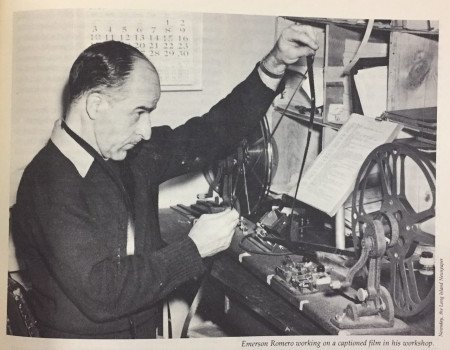Emerson Romero’s journey from a silent film star to a pioneer of accessibility advocacy is one of resilience, innovation, and a relentless drive to uplift the deaf community. Often overshadowed by mainstream cinematic legends, Romero’s contributions to media accessibility and representation have left an indelible mark on the entertainment world. His untold story reveals the power of turning personal challenges into transformative change.

A Star in the Silent Film Era
Born into a hearing family, Emerson Romero found his calling in the early days of cinema. The silent film era, characterized by visual storytelling and intertitles, offered a platform where emotion and expression took center stage. Romero’s talent as an actor shone brightly, earning him the nickname “El Mimo” (The Mime) for his ability to convey complex emotions without words.
However, the advent of sound films in the late 1920s marked a turning point. Dubbed “talkies,” these movies revolutionized the industry by incorporating spoken dialogue, sidelining not only silent film actors but also deaf audiences. For Romero, who had lost his hearing at a young age, this transition represented both a personal and professional upheaval.
The Shift to Advocacy
While many actors of the silent era faded into obscurity, Romero took a different path. Witnessing the exclusion of deaf individuals from the new era of cinema, he decided to act—not in front of the camera but behind the scenes. He recognized that sound films created a barrier for the deaf community and dedicated himself to addressing this inequality.
Romero began experimenting with ways to make sound films accessible. His most groundbreaking work involved manually adding subtitles to film reels, an early precursor to closed captioning. This labor-intensive process required splicing text directly onto film, a painstaking effort that demonstrated his commitment to inclusivity.
Pioneering Closed Captioning
Romero’s subtitle innovation was more than a technical achievement; it was a profound statement on the importance of accessibility. At a time when the entertainment industry largely ignored the needs of minority audiences, Romero’s work highlighted the potential for cinema to be a shared experience.
While his efforts were not widely recognized during his lifetime, they laid the foundation for future advancements in media accessibility. Closed captioning, now a standard feature across various platforms, owes much to Romero’s early work. His determination to make cinema inclusive was ahead of its time and continues to impact millions of viewers today.
Advocacy Beyond Film
Romero’s commitment to accessibility extended beyond the realm of cinema. He became a vocal advocate for deaf rights, collaborating with organizations to raise awareness about the challenges faced by the deaf community. Romero’s advocacy emphasized the importance of representation and inclusion, urging society to recognize the contributions and needs of deaf individuals.
He also championed the idea that accessibility was not a privilege but a fundamental right. His work inspired a movement that sought to break down barriers not only in media but also in education, employment, and public spaces.
Legacy in Deaf Cinema
Romero’s pioneering spirit continues to influence deaf cinema today. His advocacy for authentic representation has inspired filmmakers to create stories that celebrate deaf culture and challenge stereotypes. Films like Sound of Metal and CODA reflect the growing recognition of deaf experiences in mainstream media, a development that can be traced back to Romero’s groundbreaking efforts.
Moreover, Romero’s work paved the way for the creation of films by and for the deaf community. His belief in the power of storytelling to foster understanding and empathy remains a cornerstone of modern deaf cinema.
Recognition and Rediscovery
Although Emerson Romero’s contributions went largely unacknowledged during his lifetime, recent years have seen a resurgence of interest in his work. Historians, accessibility advocates, and filmmakers have begun to shine a light on his life, recognizing him as a trailblazer who changed the course of media history.
Documentaries, academic studies, and public tributes have brought Romero’s story to new audiences, ensuring that his legacy is preserved. His innovations in captioning and his advocacy for deaf rights are celebrated as pivotal moments in the fight for inclusivity.
Inspiration for Future Generations
Emerson Romero’s story is a powerful reminder of the importance of perseverance and innovation. His work demonstrates that barriers, no matter how insurmountable they may seem, can be overcome with creativity and determination. For today’s advocates of accessibility, Romero’s journey serves as both an inspiration and a call to action.
The technologies that build on his legacy—from automatic captioning to virtual sign language interpretation—continue to transform media for the better. As we strive for a more inclusive society, Romero’s life reminds us of the transformative power of one person’s vision to create lasting change.
Conclusion
The untold story of Emerson Romero is one of resilience, advocacy, and innovation. From his early days as a silent film actor to his pioneering work in accessibility, Romero’s contributions have left an enduring legacy. His efforts not only revolutionized how media is experienced but also brought greater awareness to the importance of inclusivity.
As we celebrate his life and achievements, we are reminded that true progress comes from challenging the status quo. Romero’s story encourages us to continue striving for a world where everyone, regardless of ability, can fully participate in the narratives that shape our lives.
